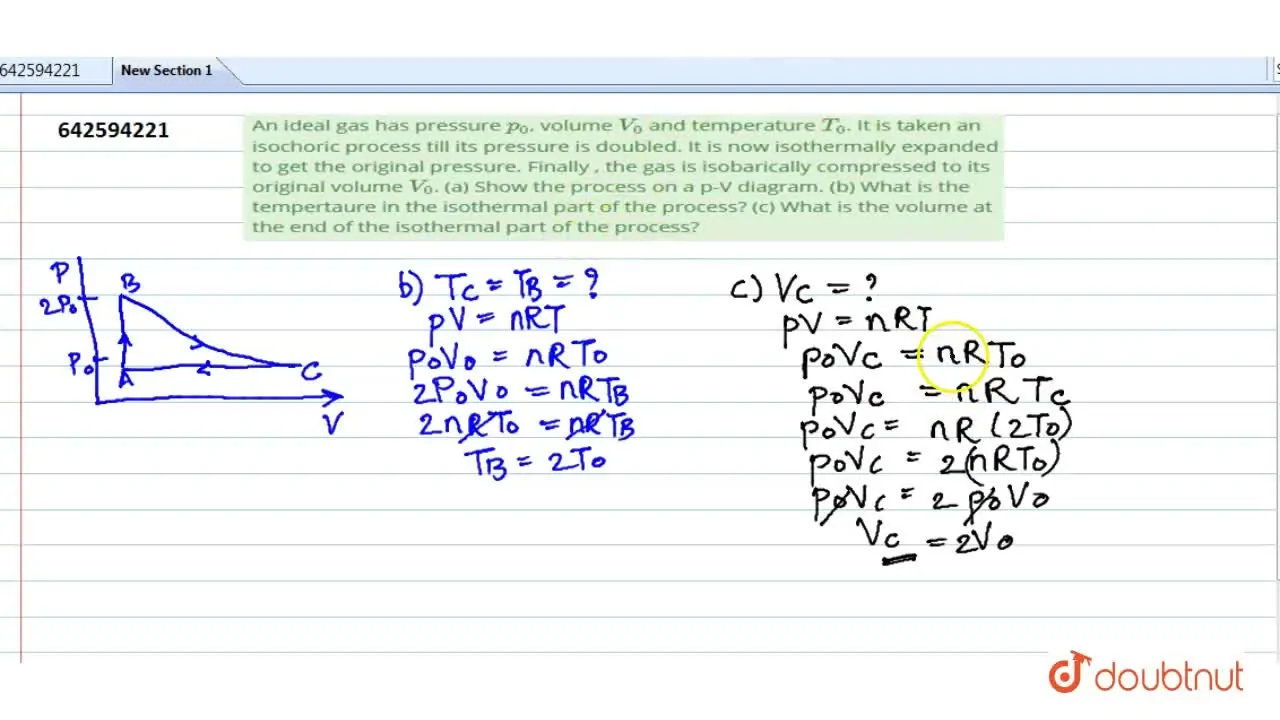An ideal gas has pressure p0, volume V0 and temperature T0. It is taken an isochoric process till its pressure is doubled. It is now isothermally expanded to get the original pressure. Finally , the gas is isobarically compressed to its original volume V0. (a) Show the process on a p-V diagram. (b) What is the tempertaure in the isothermal part of the process? (c) What is the volume at the end of the isothermal part of the process?
The process is shown in a p−V diagram in figure. The process starts from A and goes through ABCD
 <br>(b)Apply∈gpV = nRT at A and B<br>p_(0)V_(0)=nRT_(0)<br>and(2p_(0)V_(0)=n RT_(B)<br>thus,T_(B) = 2 T_(0)<br>Thusisthetemperatrue∈theisothermalpartsBC,<br>(c)AstheprocessBCisisothermalT_(C) = T_(B) = 2T_(0)apply∈gpV = nRTatAandC<br>p_(0)V_(0)=nRT_(0)<br>andp_(0)V_(c)=nRT(2T_(0))<br>or,V_(c)=2V_(0).
<br>(b)Apply∈gpV = nRT at A and B<br>p_(0)V_(0)=nRT_(0)<br>and(2p_(0)V_(0)=n RT_(B)<br>thus,T_(B) = 2 T_(0)<br>Thusisthetemperatrue∈theisothermalpartsBC,<br>(c)AstheprocessBCisisothermalT_(C) = T_(B) = 2T_(0)apply∈gpV = nRTatAandC<br>p_(0)V_(0)=nRT_(0)<br>andp_(0)V_(c)=nRT(2T_(0))<br>or,V_(c)=2V_(0).
Related Playlists
Similar Questions
A sample of an ideal gas has pressure p0, volume V0 and tempreture T0. It is isothermally expanded to twice its oringinal volume.it is then compressed at constant pressure to have the original volume V0. Finally, the gas is heated at constant volume to get the original tempreture.(a) show the process in a V-T diagram (b) calculate the heat absorbed in the process.
View SolutionA mass of ideal gas at pressure P is expanded isothermally to four times the originl volume and then slowly compressed adiabatically to its original volume. Assuming γ to be 1.5 , the new pressure of the gas is
View SolutionAn ideal gas at 300K is expanded isothermally to double its volume,then pressure of the gas will be
View SolutionAn ideal gas intially has pressure P volume V and temperature T. Its is isothermally expanded to four times of its original volume, then it is compressed at constant pressure to attain its original volume V. Finally, the gas is heated at constant volume to get the original temperature T. (a) Draw V−T curve (b) Calculate the total work done by the gas in the process.(given ln2=0.693)
View SolutionThree moles of an ideal gas at a pressure PA and temperature TA is isothermally expanded to twice its initial volume. It is then compressed at constant pressure to its original , volume. Finally the gas is compressed at constant volume to its original pressure PA
(a) Sketch the P-V and P-T diagrams for the complete process.
(b) Calculate the net work done by the gas, and net heat supplied to the gas during the complete process.View SolutionAn inflated rubber ballon contains one mole of an ideal gas , has a pressure P, volume V and temperature T. If the temperature rises to 1.1 T, and the volume isincreased to 1.05 V, the final pressure will be
View SolutionAn inflated rubber balloon contains one mole of an ideal gas has a pressure p, volume V and temperature T. if the temperature rises to 1.1 T, and the volume is increased to 1.05 V, the final pressure will be
View SolutionAn inflated rubber balloon contains one mole of an ideal gas has a pressure p, volume V and temperature T. if the temperature rises to 1.1 T, and the volume is increased to 1.05 V, the final pressure will be
View SolutionAn ideal gas with pressure P, volume V and temperature T is expanded isothermally to a volume 2V and a final pressure Pi, If the same gas is expanded adiabatically to a volume 2V, the final pressure Pa. The ratio of the specific heats of the gas is 1.67. The ratio PaP1 is .......
View SolutionAn ideal gas with pressure P, volume V and temperature T is expanded isothermally to a volume 2V and a final pressure Pi, If the same gas is expanded adiabatically to a volume 2V, the final pressure Pa. The ratio of the specific heats of the gas is 1.67. The ratio PaP1 is .......
View Solution


